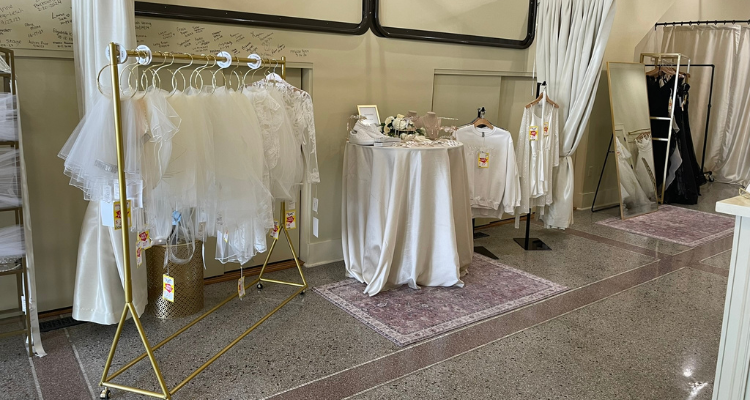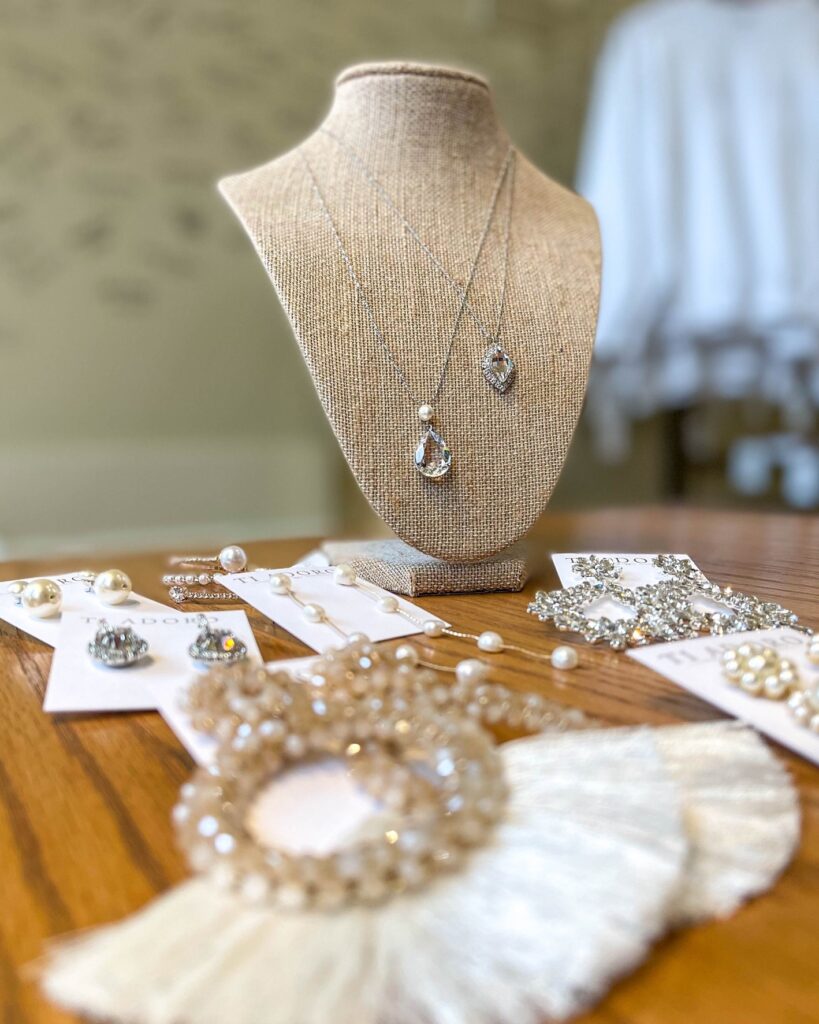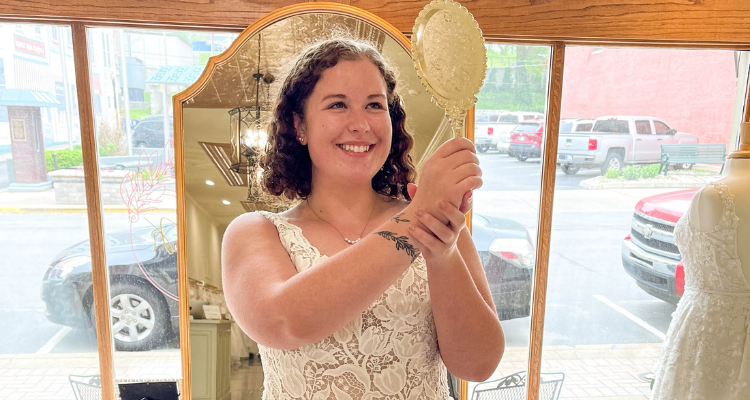
Understanding the types of fabric for wedding dresses is crucial for anyone involved in the wedding planning process. These fabrics are the foundation upon which the entire design rests, and each material offers distinct characteristics that can accentuate or downplay specific elements of a gown. Choosing the right fabric can make a significant difference in the overall look and feel of the dress, transforming a simple silhouette into an extraordinary masterpiece. Here, we delve into some of the most sought-after wedding dress materials, highlighting their unique properties and the types of wedding aesthetics they best complement. By understanding these elements, brides and boutique owners can create a wedding day look that truly reflects personal style and vision.
Understanding the Types of Fabric for Wedding Dresses
Bridal gown fabrics are the foundation upon which the entire design rests. Each material offers distinct characteristics that can accentuate or downplay specific elements of a gown. Fabrics play a pivotal role in determining the dress’s overall look, movement, and how it feels against the skin. They can influence everything from the silhouette to the level of comfort, ensuring the bride feels both beautiful and at ease throughout her wedding day. Here, we delve into some of the most sought-after wedding dress materials, highlighting their unique properties and the types of wedding aesthetics they best complement. Understanding these fabrics can help brides and boutique owners make choices that enhance the gown’s design and complement the wedding’s theme.
Satin: Timeless Elegance
Satin is synonymous with luxury and sophistication. Known for its smooth, lustrous surface, satin is a favored choice for brides seeking a classic and elegant look. This fabric is versatile, draping beautifully and holding structured shapes with ease. Its weight varies, offering options for both form-fitting and voluminous designs. Satin’s adaptability makes it an excellent choice for various wedding settings, from grand ballroom affairs to intimate garden ceremonies.
Satin gowns often evoke a sense of old-world glamour, making them ideal for traditional and formal weddings. Moreover, satin’s smooth texture captures light exquisitely, adding a radiant glow to the bride’s ensemble. The fabric’s sheen enhances the gown’s elegance, ensuring the bride stands out on her special day. Additionally, satin’s durability and resistance to wrinkling make it a practical choice for brides who want to maintain a polished appearance throughout their wedding festivities.
Tulle: Whimsical and Ethereal
For brides dreaming of a fairy-tale wedding, tulle is the quintessential fabric. Light and airy, tulle creates a soft, ethereal silhouette reminiscent of ballerina tutus. It’s commonly used for voluminous skirts, veils, and delicate overlays, providing an enchanting quality to any gown. Tulle’s versatility allows designers to experiment with layers and textures, resulting in gowns that are both imaginative and dreamy.
Tulle’s sheer quality allows for layering, resulting in a voluminous appearance without overwhelming weight. It pairs beautifully with embellishments like lace appliqués or beaded embroidery, adding texture and depth to the overall design. The fabric’s delicate nature encourages a sense of movement and grace, perfect for brides who envision a romantic and whimsical atmosphere. Whether used sparingly or extensively, tulle adds a magical touch to wedding gowns, capturing the imagination of brides and guests alike.
Lace: Romantic and Timeless
Lace is the epitome of romance and timelessness in bridal fashion. With its intricate patterns and delicate texture, lace adds an element of sophistication and femininity to wedding dresses. It can be used as an overlay or as a standalone fabric, offering versatility in design. Lace’s classic appeal ensures it remains a favorite choice for brides seeking a touch of elegance and tradition in their wedding attire.
Lace is available in various styles, such as Chantilly, Alençon, and Guipure, each offering a distinct aesthetic. Whether used sparingly for subtle accents or extensively for a vintage-inspired gown, lace remains a perennial favorite in bridal fashion. The fabric’s ability to convey both modern and traditional sensibilities makes it suitable for a wide range of wedding themes. Lace’s timeless beauty ensures that brides who choose it will look back on their wedding photos with fondness and pride.
Chiffon: Effortlessly Elegant
Chiffon is celebrated for its lightweight and flowing nature, making it a preferred choice for warm-weather weddings and destination ceremonies. This sheer fabric creates an effortless, ethereal appearance, ideal for brides seeking a relaxed yet elegant look. Chiffon’s breezy quality makes it perfect for outdoor weddings, where comfort and style are equally important.
Chiffon’s soft drape lends itself well to layered designs, adding a sense of movement and grace. It can be used for both structured and loose-fitting styles, offering flexibility in achieving various bridal aesthetics. The fabric’s versatility allows designers to create gowns that transition seamlessly from ceremony to reception. Chiffon’s understated elegance ensures that brides can enjoy their special day with ease and sophistication.
Organza: Structured and Airy
Organza combines the best of both worlds, offering the structure of tulle with a softer, more delicate touch. This crisp, sheer fabric is perfect for creating voluminous skirts and dramatic silhouettes without the weight of heavier materials. Organza’s ability to maintain shape while allowing for movement makes it an excellent choice for brides who desire a dynamic and striking appearance.
Organza’s translucent quality allows for intricate detailing and layering, adding depth and dimension to the gown. It’s an excellent choice for brides who desire a blend of structure and softness in their wedding attire. The fabric’s versatility enables designers to craft gowns that are both bold and romantic, ensuring each bride’s vision is brought to life. Organza’s unique properties make it a standout choice for those looking to make a memorable entrance.
Making Bold Fashion Choices
In the realm of bridal fashion, embracing individuality and making bold fashion choices is increasingly celebrated. As a bridal boutique owner or a bride-to-be, understanding the nuances of wedding dress materials can empower you to make informed decisions that reflect personal style and flair. By exploring a variety of fabrics and experimenting with textures, brides can create a look that is uniquely their own, ensuring their wedding day is a true reflection of their personality.
Exploring Unconventional Fabrics
While traditional fabrics like satin, lace, and chiffon remain popular, there’s a growing interest in unconventional materials that offer unique textures and visual appeal. Consider options like crepe, a fabric known for its slightly crinkled texture and excellent draping qualities, or mikado, a blend of silk and nylon that offers a luxurious sheen and structured finish. These materials provide opportunities for brides to express their individuality and stand out from the crowd.
Unconventional fabrics can add an unexpected twist to bridal fashion, allowing brides to showcase their distinct personalities and make a memorable statement on their special day. By stepping away from tradition, brides can explore a world of possibilities in wedding gown design. These unique fabrics encourage creativity and innovation, resulting in gowns that are truly one-of-a-kind.
Mixing and Matching Textures
Another trend gaining traction is the mixing and matching of different fabrics to create multidimensional designs. Pairing lace with chiffon, for example, can result in a harmonious blend of romance and elegance, while combining tulle with satin offers a contrast between softness and structure. This approach allows brides to craft a gown that captures their vision, blending elements that resonate with their personal style.
Experimenting with textures allows for creativity in design, enabling brides to customize their gowns to suit their unique vision. This approach encourages bridal boutique owners to offer diverse selections that cater to a wide range of tastes and preferences. By providing options that mix traditional and modern elements, boutiques can appeal to brides seeking a personalized and innovative wedding dress experience.
Practical Tips for Bridal Boutique Owners
As a bridal boutique owner, staying abreast of the latest trends in wedding dress materials is essential to offering your clients the best possible selection. Here are some practical tips to enhance your boutique’s offerings:
- Educate Your Staff: Ensure your team is knowledgeable about different fabrics and their properties. This expertise enables them to guide brides in selecting materials that align with their desired aesthetic and comfort level. Training sessions and workshops can keep staff updated on new materials and trends.
- Diversify Your Inventory: Stock a variety of fabrics, including both traditional and unconventional options. This diversity allows you to cater to a broader clientele with varying tastes and style preferences. By offering a wide range of options, you can accommodate brides seeking both classic and contemporary styles.
- Offer Customization Options: Collaborate with designers who offer customization services, allowing brides to mix and match fabrics and create bespoke designs. This personalized approach enhances customer satisfaction and sets your boutique apart. Customization options can attract brides looking for a unique gown tailored to their specific vision.
- Stay Informed on Trends: Regularly update your inventory based on emerging trends in bridal fashion. Attend bridal shows, follow fashion publications, and engage with industry experts to stay ahead of the curve. By staying informed, you can anticipate changes in bridal fashion and meet the evolving demands of your clientele.
By embracing the diversity of bridal gown fabrics and encouraging bold fashion choices, you can elevate your boutique’s reputation and provide brides with the wedding attire of their dreams. With a keen understanding of wedding dress materials, you’ll be well-equipped to guide your clients in making choices that reflect their individuality and make a lasting impression. Your boutique can become a destination for brides seeking both timeless elegance and modern innovation in their wedding attire.


